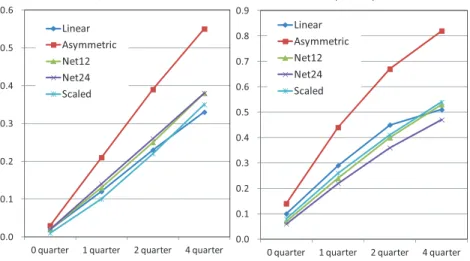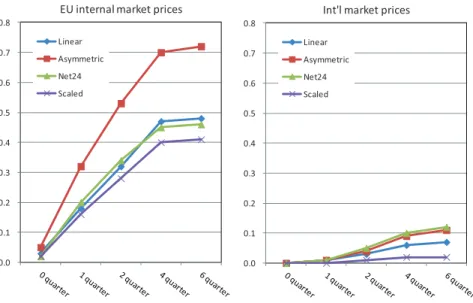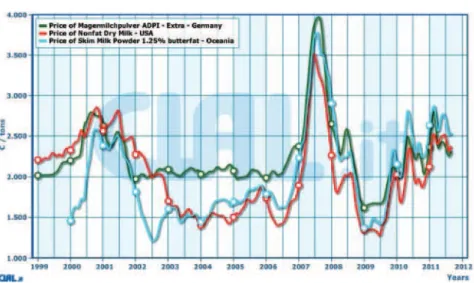the Euro Area: Non-Linearities and the Role of
the Common Agricultural Policy”
Tsutomu Watanabe
University of Tokyo
1. Contributions of the Paper
The link (or lack of link) between food commodity prices and con- sumer prices is an important issue not only for academics but also for policymakers. This paper asks how and to what extent changes in food commodity prices spill over to consumer prices, using a new data set for the euro area as well as a new empirical approach. The authors find that there is a statistically significant link between food commodity prices and consumer prices, which is quite different from the findings of previous studies.
The contributions of this paper can be summarized as follows. First, the paper makes a clear distinction between food prices in European Union (EU) internal markets (e.g., farm gate and inter- nal prices of skim milk powder in a country belonging to the EU) and those in international markets (e.g., export prices of skim milk powder from the United States or Oceania). The paper uses the for- mer prices to examine the link between food commodity prices and consumer prices. This is an important departure from previous stud- ies, which typically use international food prices. The authors argue that the difference between internal and international food prices is, at least partially, accounted for by the presence of the Common Agricultural Policy (CAP) in the EU. For example, if the internal market price of a particular food item, such as skim milk powder, falls below a certain threshold level, then the EU authorities will buy up goods to raise the price to the threshold level. The paper finds that the discrepancy between internal and international food prices created by these interventions is not trivial, and argues that
219
previous studies using international prices underestimate the degree of pass-through.
Second, the paper employs non-linear specifications in the regres- sion analysis. This is another important departure from previous studies. The paper adopts three types of non-linear specifications and compares the results with the result obtained from the type of linear specification typically adopted in previous studies. Specif- ically, it adopts (i) an asymmetric specification (i.e., positive and negative food price inflation is allowed to deliver different outcomes); (ii) a scaled specification (allowing for the possibility that the size of food price inflation relative to the (time-varying) volatility of the disturbance term matters); and (iii) a net specification (allowing for the possibility that the level of food prices relative to their past val- ues matters; i.e., there exist some sort of threshold effects in terms of the food price level).
In what follows, I will first make some comments on the non- linear specifications and then proceed to discuss some issues related to the discrepancy between international and internal prices.
2. Linear versus Non-Linear Specifications
First of all, I would like to touch on an interesting result provided by the National Bank of Belgium (2008). Using micro price data, they look at how the frequency of price changes as well as the size of price changes responded to the food price hike that started in mid- 2007. What they find for food items such as milk, cheese, and eggs is that the frequency of price changes, especially the frequency of price increases, exhibited a sharp increase in the latter half of 2007, while the size of price changes remained unchanged. In other words, the extensive margin played a more important role during the price hike in 2007 than the intensive margin. Importantly, this is not consistent with time-dependent pricing, which is typically assumed in dynamic stochastic general equilibrium (DSGE) models. The finding implies that price dynamics governing food prices may not be as simple as assumed in standard DSGE models and researchers therefore need to pay particular attention to the specification of estimating equations when conducting analyses of food price pass-through using aggre- gate price data. In this sense, not sticking to linear specifications
Figure 1. Linear vs. Non-Linear Specifications
1 0.0
0.1 0.2 0.3 0.4 0.5 0.6
0 quarter 1 quarter 2 quarter 4 quarter CumulaƟve impulse responses of HICP food
Linear Asymmetric Net12 Net24 Scaled
0.0 0.1 0.2 0.3 0.4 0.5 0.6 0.7 0.8 0.9
0 quarter 1 quarter 2 quarter 4 quarter CumulaƟve impulse responses of PPI food
Linear Asymmetric Net12 Net24 Scaled
but instead trying various non-linear specifications is a step in the right direction.
The procedure adopted in the paper is a standard one: the authors estimate four types of pass-through equations, consisting of a linear specification and the three kinds of non-linear specifica- tions mentioned above, and then conduct model selection based on information criteria. As reported in tables 2 and 6 of the paper, the non-linear specifications, especially the scaled specification, perform better than the linear specification for almost all food items. Based on these results, the authors argue that non-linearity is a crucial issue and that previous studies’ failure to detect pass-through is due to their sticking to linear specifications.
Let me take a careful look at their results. Figure 1 shows the cumulative impulse responses of HICP food (left panel) and PPI food (right panel) to a food price shock. Both panels are produced using the numbers reported in tables 4, 10, and 11 of the paper. The figure shows that the response in the scaled specification, which has the highest information criterion scores, is almost identical to the response in the linear specification, although the response in the asymmetric specification is slightly larger than the responses in the other specifications. That is, the three types of non-linear specifications adopted here outperform the linear specification in
Figure 2. Internal vs. International Food Prices
0.0 0.1 0.2 0.3 0.4 0.5 0.6 0.7 0.8
EU internal market prices
Linear Asymmetric Net24 Scaled
0.0 0.1 0.2 0.3 0.4 0.5 0.6 0.7 0.8
Int'l market prices
Linear Asymmetric Net24 Scaled
terms of the information criteria, but the difference is not economi- cally significant.
However, this does not necessarily imply that we should go back to a linear specification. Instead, I would like to emphasize once again that, given the micro price evidence explained earlier, it is a step in the right direction to employ non-linear specifications. What would be interesting for future research is to see how the results change if other kinds of non-linear specifications are employed. In addition, it would be desirable to have a detailed discussion on why and what type of non-linear specifications are justified from a theoretical viewpoint.
3. International versus Internal Prices
Let me move on to the second comment, which is about the dis- crepancy between international and internal prices. Figure 2 com- pares the cumulative impulse responses of HICP food to a shock to internal food prices (left panel) and to a shock to international food prices (right panel). The figure is produced from the estimated results reported in table 5 of the paper. The figure clearly shows
that the impact is much greater in the case of internal food prices, suggesting that the discrepancy between internal and external prices is not trivial. Thus, one may wonder where this discrepancy comes from. Why do changes in international food prices not spill over to consumer and producer prices in the euro area? The paper focuses on the role of the CAP, namely, the intervention by EU authorities in the market to stabilize food prices for the purpose of protecting domestic food industries.
My comments on the discrepancy between internal and interna- tional prices are as follows. First, I am not fully persuaded that the discrepancy comes only from the CAP. The CAP probably plays a dominant role, but there still remain some other possibilities. For example, the discrepancy may be related to certain features of the distribution system in the EU countries. I would have liked to have seen a more careful discussion on why the authors rule out possibili- ties other than the CAP as a reason behind the discrepancy between internal and international food prices.
Second, I would have liked to have seen a more detailed expla- nation of the CAP. For example, it is repeatedly stated in the paper that EU internal prices are stabilized because of the CAP, but there is no clear description about who implements such interventions, how they are implemented, and what the purpose of such interventions is. In particular, I am curious to know whether there is any commu- nication between the European Central Bank, which is responsible for price stability in the euro area, and the authorities in charge of the CAP.
Third, the role of the CAP in stabilizing food prices in the EU may be changing over time. Some observers argue that the CAP can no longer stabilize food commodity prices. For exam- ple, the National Bank of Belgium (2008, p. 72) states that the CAP “no longer smoothes fluctuations in world prices as it used to do [, so that] fluctuations in world market prices now have a much greater impact on prices in Europe.” To see whether this is true or not, let me focus on a particular food item, skim milk powder. Figure 3, which is taken from the web site “capreform.eu” (http://capreform.eu/tag/prices/), shows developments in internal and international prices of skim milk powder. Interestingly, the inter- nal price stayed somewhere around 2,000 euros per ton in 2003–06, while international prices were far below that level during the same
Figure 3. Internal and International Prices of Skim Milk Powder
Source:CLAL.it.
period. It seems that the target price was set at 2,000 euros, and interventions were conducted to prevent internal prices from falling below that level. In the first half of 2007, international prices regis- tered a sharp rise, which the internal price followed. A straightfor- ward interpretation of this would be that international prices were above the target level during this period, so that there was no need to intervene. However, something quite different happened when inter- national prices fell sharply from 4,000 euros per ton to below 1,500 euros per ton in 2007–09. Interestingly, this time the internal price declined together with international prices, reaching a level far below 2,000 euros per ton. I do not know why this happened, but it seems that the EU authorities did not intervene during this period. In fact, figure 3 indicates that there was a structural break somewhere in 2006: internal and international prices were not closely correlated until then, but they have been highly correlated since. This seeming synchronization of international and internal prices in recent years may be an indication that the role of the CAP has changed.
Needless to say, this is just an example. It may be the case that internal prices of other food products behaved differently from the internal price of skim milk powder, and before concluding that the
role of the CAP and, as a result, the correlation between internal and international prices have changed, it would be necessary to investi- gate more closely what happened to the prices of other food prod- ucts. Specifically, I think it would be useful to conduct a structural break test to examine whether the link between internal and inter- national food prices changed sometime around 2006, as seems to be the case for skim milk powder.
References
National Bank of Belgium. 2008. “Processed Food: Inflation and Price Levels.” In “The Trend in Inflation in Belgium: An Analysis by the NBB at the Request of the Federal Government,” special edition, Economic Review (National Bank of Belgium) (April): Annex D, 53–72.


